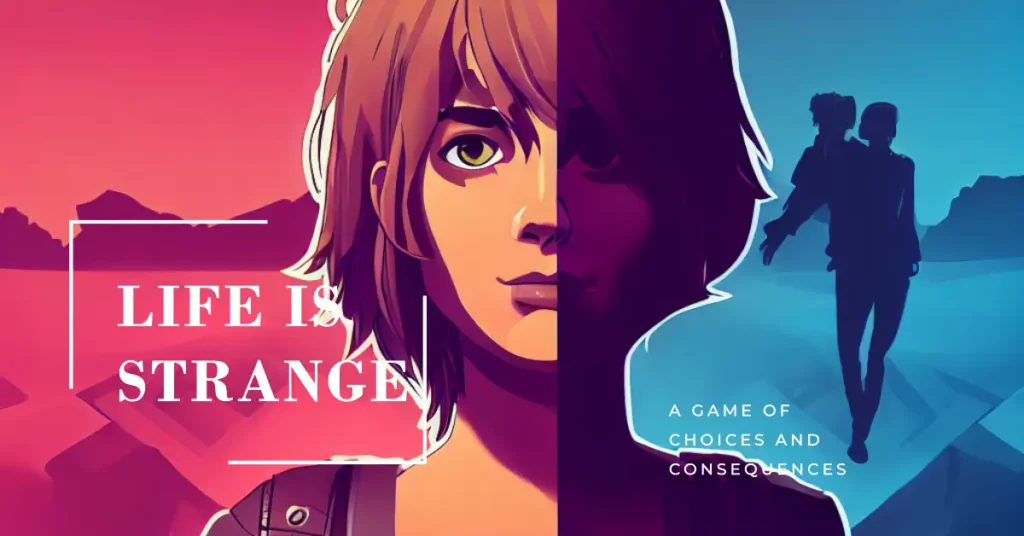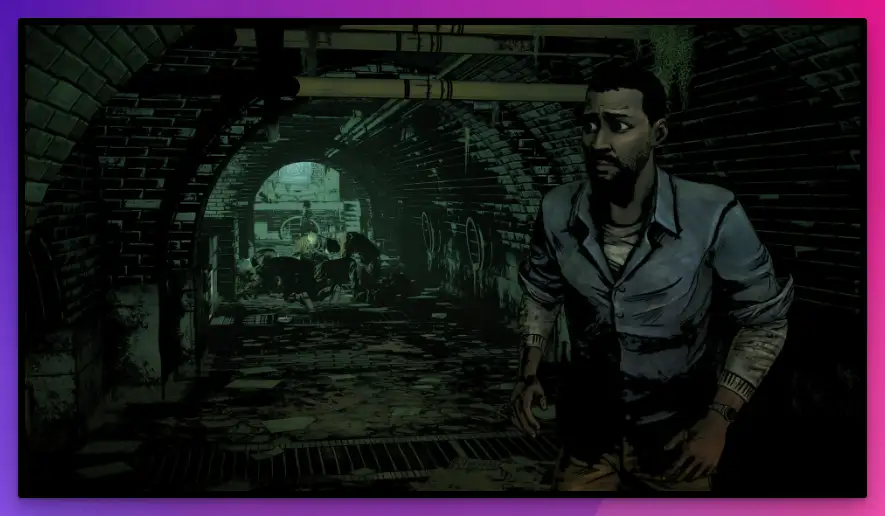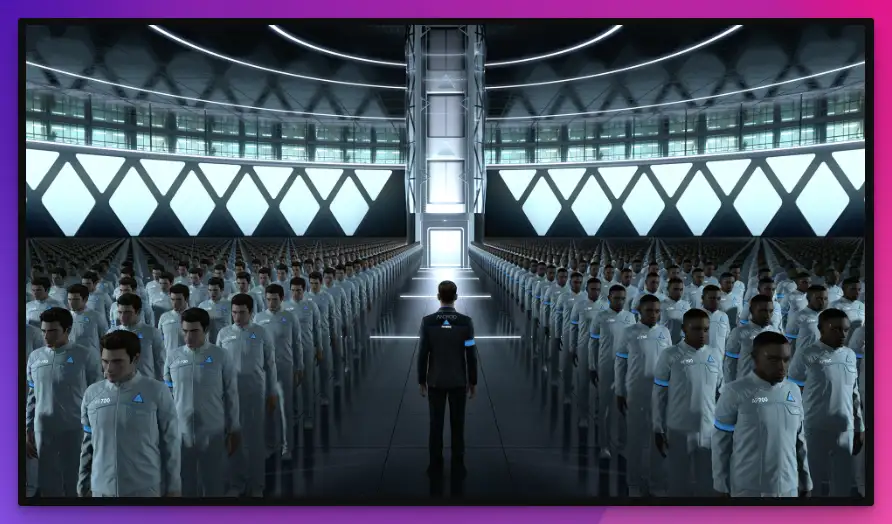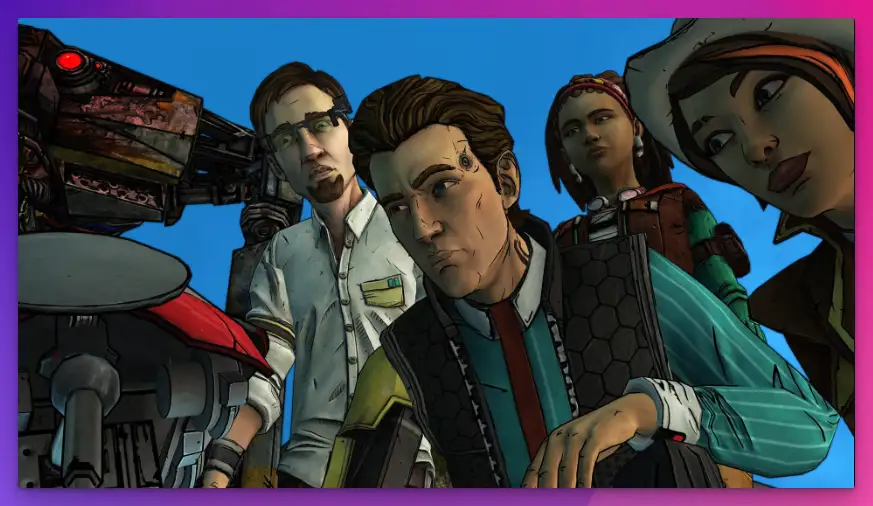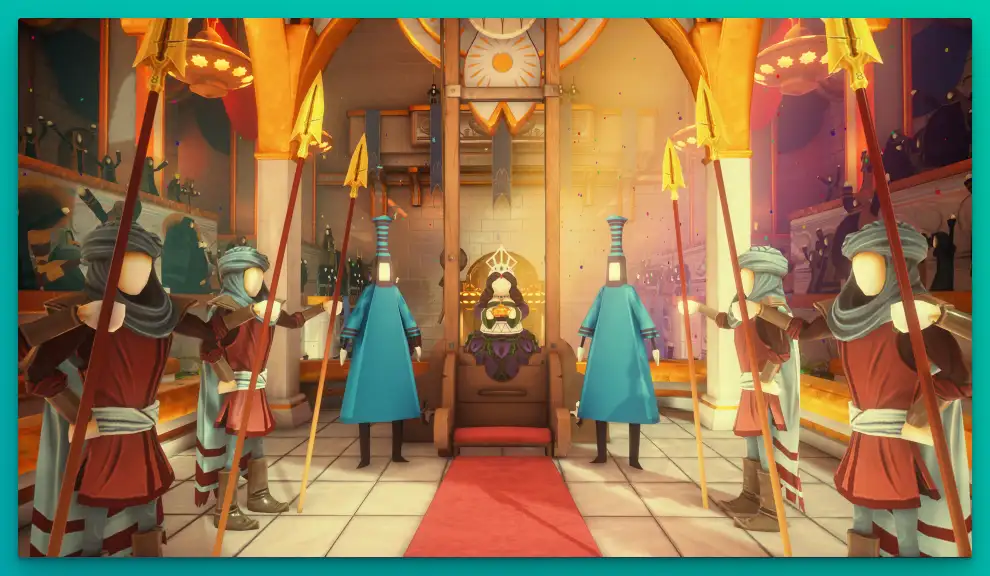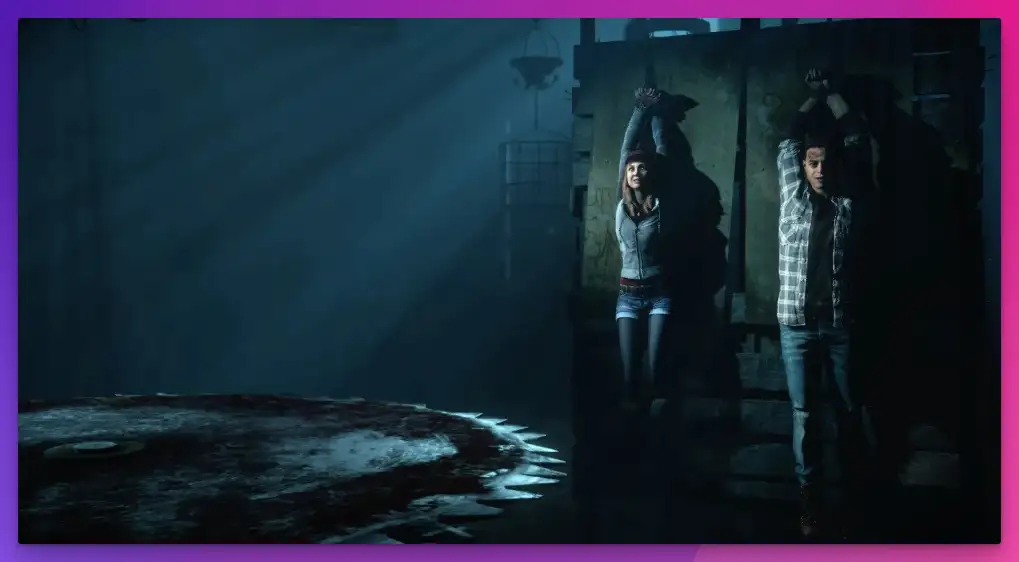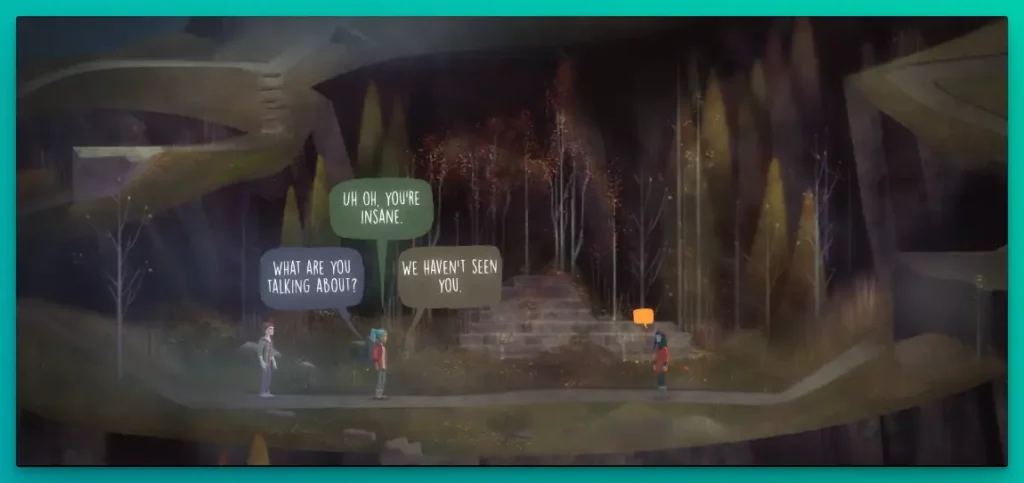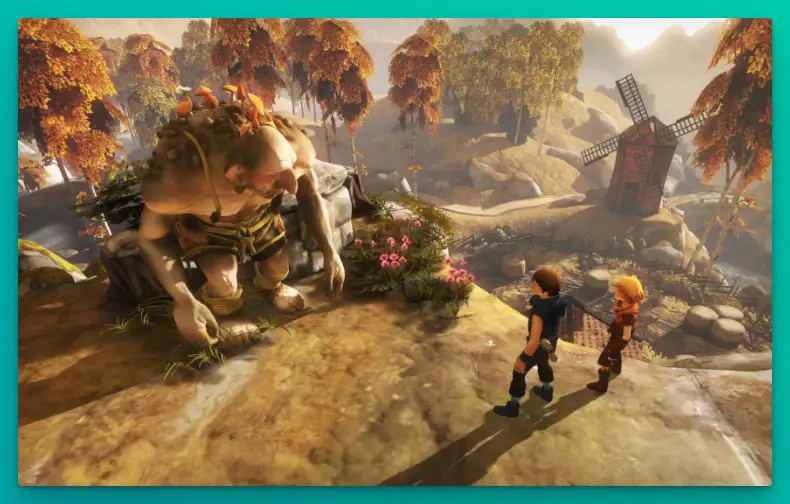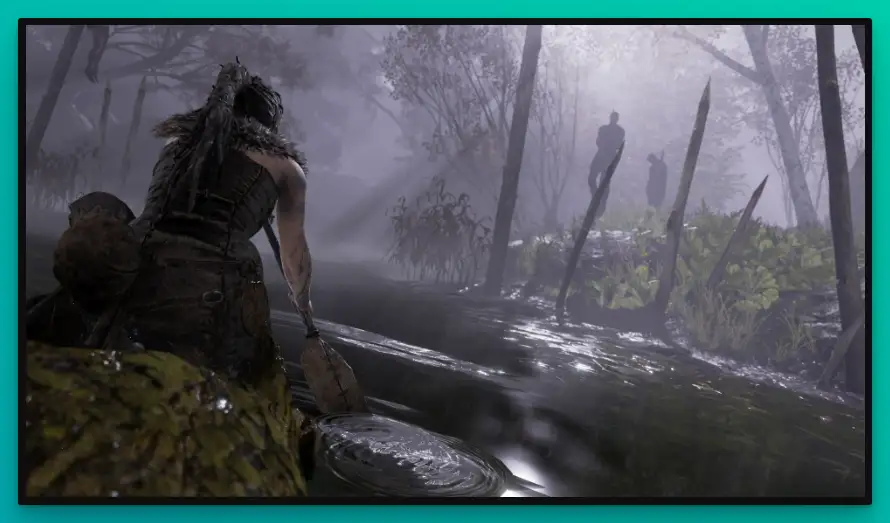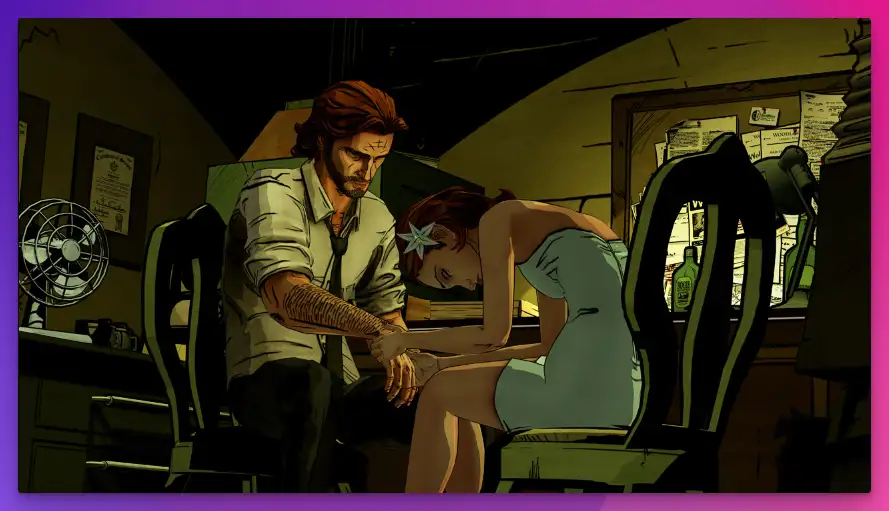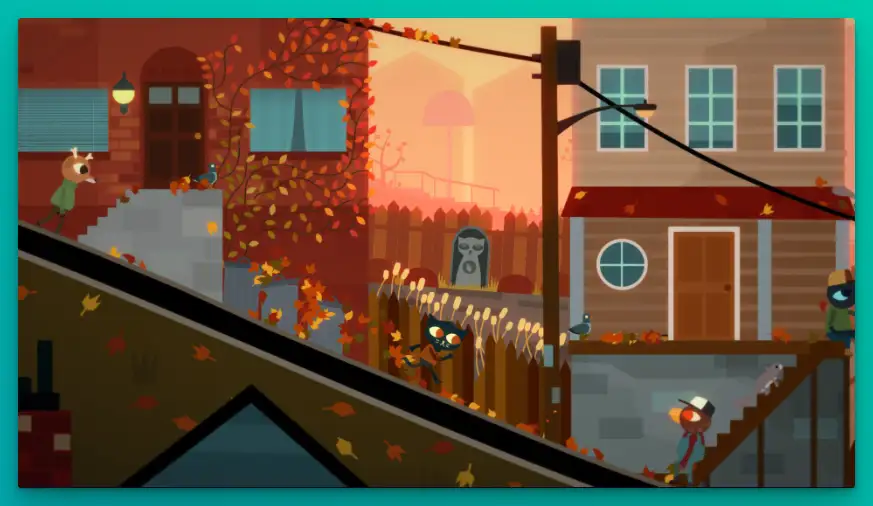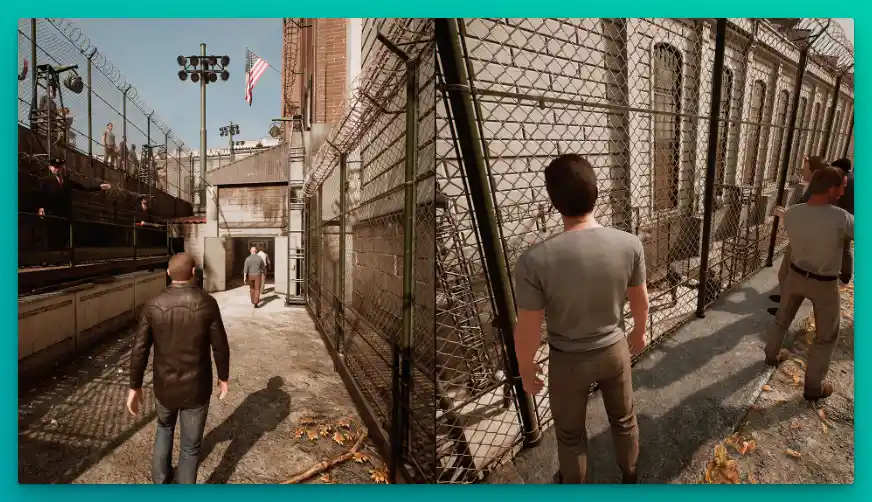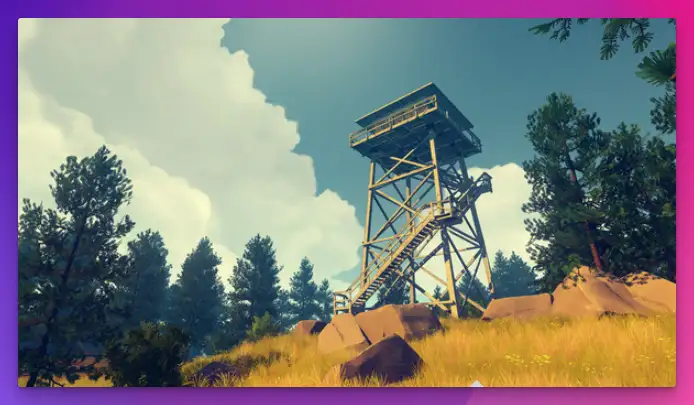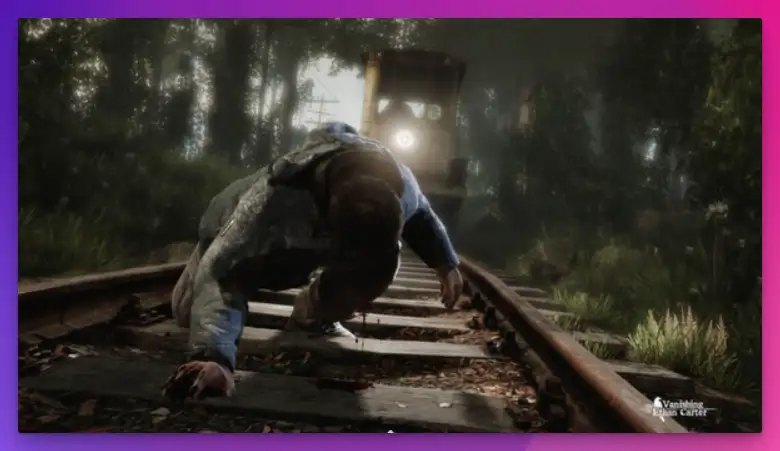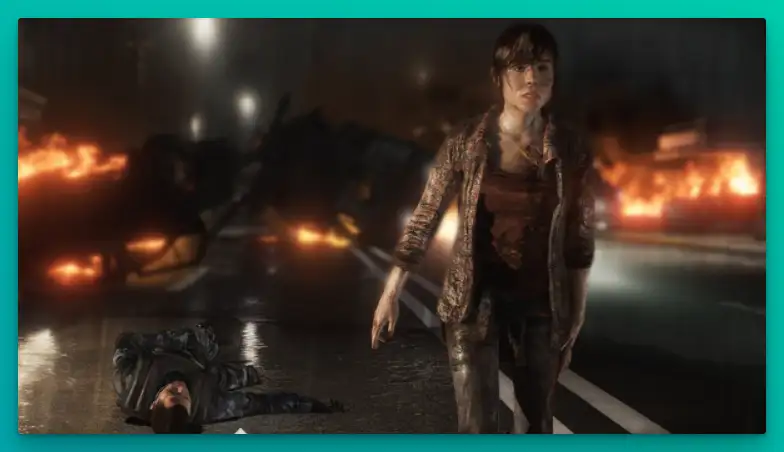Have you ever found yourself in a gaming rut, constantly scouring for a new game that offers the same emotional depth and immersive gameplay as Life is Strange?
It’s a game that sets the bar high with its unique time manipulation mechanics, profound character development, and meaningful choice-based outcomes.
You might have been left wondering if other games could replicate the unique gaming experience that Life is Strange provides.
We understand the struggle. Rummaging through numerous games can be deeply frustrating, only to find that they lack the same level of storytelling depth, emotional resonance, or intricate gameplay mechanics.
Maybe some games capture the narrative feel but fail to deliver on player choice and consequence. Or perhaps they miss the mark when creating believable, relatable characters. Finding games that truly match the full package that Life is Strange delivers is challenging.
That’s where we come in. We’ve sifted through the sea of narrative-driven games and have created a curated list of titles that embody the spirit and gameplay elements of Life is Strange.
This article explores “games like Life is Strange, ” which offer intricate storylines, consequential decision-making, rich characters, and some unique gameplay mechanics.
Whether you’re a die-hard Life is Strange fan or a newcomer to this gaming genre, we’re confident you’ll discover new games to fall in love with. So, let’s delve into this exciting journey together.
Features that Make Life is Strange Unique
Life is Strange, developed by Dontnod Entertainment, is an extraordinary interactive adventure game that stands out among its peers due to several distinctive features.
Its blend of compelling narrative, intricate character development, and innovative time-rewinding mechanic creates an immersive experience that captivates players from start to finish.
One of the unique aspects of Life is Strange is its emphasis on choice and consequence. Players are presented with morally challenging decisions throughout the game, each having far-reaching implications on the story and character relationships.
The consequences of these choices are not always immediate, often unfolding over time, creating a sense of anticipation and unpredictability.
Another standout feature is the game’s aesthetic art style. Life is Strange employs a combination of hand-painted textures and cel-shaded visuals, giving it a visually distinct and evocative look.
The artistic direction enhances the game’s emotional impact, creating a surreal and dreamlike atmosphere that mirrors the game’s themes of nostalgia and coming-of-age.
The musical score of Life is Strange also plays a vital role in its uniqueness. The game features an eclectic soundtrack, incorporating indie-folk, alternative rock, and ambient tunes.
These carefully selected songs complement the narrative and evoke specific moods and emotions, further immersing players into the world of Arcadia Bay.
Furthermore, Life is Strange tackles sensitive and mature topics sincerely and deeply. It addresses issues like bullying, mental health, sexuality, and the challenges of growing up, presenting them compassionately and thoughtfully.
This maturity sets Life is Strange apart from many other games, as it treats its subject matter with respect and encourages players to reflect on these real-life themes.
Lastly, the game’s time-rewinding mechanic allows players to alter choices and experiment with different outcomes. This unique gameplay feature adds a layer of strategic thinking and emphasizes that actions have consequences.
The ability to rewind time creates a dynamic gameplay experience, allowing players to navigate complex scenarios and make decisions based on the information gained from multiple perspectives.
In conclusion, Life is Strange offers a unique and captivating gaming experience. Its emphasis on choice and consequence, distinctive art style, thought-provoking themes, carefully curated soundtrack, and innovative time-rewinding mechanic combine to create a game that stands out in interactive storytelling.
Whether you’re a fan of narrative-driven games or simply looking for a compelling and immersive experience, Life is Strange is a title that should not be missed.
Top Games Like Life is Strange To Uncover Similar Stories
1. The Walking Dead (Telltale Series)
Regarding captivating interactive storytelling, few games can rival the The Walking Dead (Telltale Series). This episodic adventure game shares many similarities with Life is Strange, making it a top choice for fans of the latter.
Let’s explore why The Walking Dead is a game worth exploring for those seeking a similar experience.
The Walking Dead (Telltale Series), like Life is Strange, places great emphasis on choice-driven gameplay. Players face morally complex decisions that significantly affect the story and character relationships. These decisions are often emotionally charged, forcing players to grapple with their ethical compass in a world ravaged by a zombie apocalypse.
One of the noteworthy aspects of The Walking Dead is its compelling character development. The game introduces a diverse cast of characters, each with their own motivations and nuanced personalities.
As players progress through the story, they become deeply invested in the lives of these characters, forging meaningful connections and experiencing the emotional highs and lows of their struggles for survival.
Regarding visual presentation, The Walking Dead adopts a distinctive comic book art style, further enhancing its unique identity. The game’s cel-shaded graphics lend it a gritty and atmospheric look, perfectly suited to the post-apocalyptic setting. This visual style, combined with cinematic camera angles, immerses players in a world teetering on the brink of collapse.
Like Life is Strange, The Walking Dead tackles mature themes such as mortality, sacrifice, and morality. It explores the depths of human nature in times of crisis, challenging players to make tough decisions that blur the lines between right and wrong. The narrative unfolds with genuine tension and dread, offering a thought-provoking experience long after the game ends.
Lastly, The Walking Dead creates an intense and suspenseful gameplay experience. It seamlessly weaves together narrative-driven storytelling and action-packed sequences, keeping players on the edge of their seats.
The game’s immersive sound design and well-timed tension-building moments heighten the sense of danger and urgency, ensuring players are fully engaged in the harrowing events of the game.
In conclusion, The Walking Dead (Telltale Series) is a top game akin to Life is Strange, offering a compelling narrative, complex characters, and emotionally charged decision-making. With its unique art style, mature themes, and intense gameplay, The Walking Dead immerses players in a gripping post-apocalyptic world.
Whether you are a zombie genre fan or enjoy games that provoke thought and emotion, The Walking Dead is an exceptional choice for an immersive gaming experience.
Notable Features:-
The Walking Dead (Telltale Series) shares several notable features with Life is Strange that make it a top game in its own right.
Let’s explore some of these standout elements:-
Choice-driven gameplay: Similar to Life is Strange, The Walking Dead offers players a branching narrative where choices have far-reaching consequences. The decisions made throughout the game can determine the fate of characters and shape the overall story, providing a deeply immersive and personalized experience.
Emotional storytelling: Both games excel at delivering emotionally charged narratives. The Walking Dead masterfully weaves a tale of survival and human resilience amidst a zombie-infested world. It explores themes of loss, sacrifice, and hope, evoking emotions and creating a powerful connection between players and the characters they encounter.
Character development: The Walking Dead introduces a rich ensemble of characters with unique backgrounds and personalities. As players navigate the story, they form deep attachments to these characters, forging bonds and experiencing the highs and lows of their journeys. The game’s writing and voice acting contribute to the authenticity and depth of these memorable characters.
Atmospheric visuals: The art style of The Walking Dead combines hand-drawn comic book aesthetics with a gritty, post-apocalyptic setting. The cel-shaded graphics and meticulous attention to detail create a visually striking world that draws players into its desolate landscapes and tense environments.
Suspense and tension: Much like Life is Strange, The Walking Dead keeps players on edge seats with its expertly crafted suspense and tension. The constant threat of zombies and the moral dilemmas the characters face heighten the sense of urgency, delivering intense and gripping gameplay moments.
Moral ambiguity: Both games explore complex moral dilemmas that challenge players’ ethical compass. The Walking Dead presents choices that force players to make difficult decisions where there is often no clear right or wrong answer. This moral ambiguity adds depth to the storytelling and prompts players to reflect on their own values and beliefs.
In conclusion, The Walking Dead (Telltale Series) possesses notable features that make it a top game reminiscent of Life is Strange. Its choice-driven gameplay, emotional storytelling, well-developed characters, atmospheric visuals, suspenseful gameplay, and moral ambiguity contribute to an immersive and unforgettable gaming experience.
Whether you’re a fan of post-apocalyptic narratives or enjoy thought-provoking decision-making, The Walking Dead offers a compelling adventure that stands alongside Life is Strange in its ability to captivate players and leave a lasting impression.
Platform Availability:-
The Platform Availability of Walking Dead (Telltale Series) encompasses a broad spectrum of gaming platforms catering to diverse players. This critically acclaimed episodic adventure series has successfully infiltrated numerous gaming ecosystems, ensuring accessibility to a wide audience.
PC enthusiasts can indulge in the gripping narrative on Windows, Mac, and Linux operating systems. Delve into the post-apocalyptic world via renowned digital distribution platforms such as Steam, GOG, and the Epic Games Store.
Console aficionados have not been neglected, as PlayStation 4, PlayStation 3, Xbox One, Xbox 360, and even the portable Nintendo Switch host an enthralling experience.
Furthermore, the Walking Dead (Telltale Series) has extended its reach to mobile gaming. Players can partake in the suspenseful storytelling on their iOS or Android devices, readily available through the esteemed Apple App Store and Google Play Store.
With an extensive presence across these platforms, the Walking Dead (Telltale Series) ensures that players can immerse themselves in its rich universe, regardless of their preferred gaming setup.
2. Detroit: Become Human: An Interactive Sci-Fi Thriller
When it comes to immersive and choice-driven storytelling, few games can match the brilliance of Detroit: Become Human. This cinematic masterpiece shares several key similarities with Life is Strange, making it an excellent recommendation for fans of the latter.
Let’s explore why Detroit: Become Human stands out as a game comparable to Life is Strange.
Detroit: Become Human mirrors the choice-driven gameplay found in Life is Strange, offering players a branching narrative with profound consequences.
The game presents a futuristic world where androids have gained sentience, and players assume the roles of different android protagonists, making choices that shape the story’s outcome. Each decision carries weight and has ripple effects, leading to multiple branching paths and a personalized gaming experience.
One of the standout features of Detroit: Become Human is its remarkable attention to detail and stunning visuals. The game’s meticulously crafted environments, lifelike character models, and realistic motion capture breathe life into the futuristic city of Detroit.
The attention to detail extends to the expressive facial animations and subtle gestures, enhancing the emotional impact of the game and drawing players into its immersive world.
Like Life is Strange, Detroit: Become Human tackles socio-political themes with depth and nuance. Its thought-provoking narrative explores concepts such as artificial intelligence, discrimination, and humanity.
The game prompts players to reflect on complex moral dilemmas, challenging their preconceived notions and blurring the lines between right and wrong.
Moreover, Detroit: Become Human boasts an ensemble cast of well-developed characters, each with their story arcs and emotional journeys.
Players develop strong connections with these characters, investing in their struggles and choices. The game’s superb writing and stellar voice acting further elevate the narrative, evoking genuine emotions and creating a truly immersive experience.
Lastly, Detroit: Become Human offers multiple perspectives on the overarching story, allowing players to see the consequences of their choices from different angles.
This dynamic storytelling approach, combined with the game’s intricate branching system, offers tremendous replay value and encourages players to explore the myriad possibilities within the game.
In conclusion, Detroit: Become Human is a remarkable game akin to Life is Strange, presenting a choice-driven narrative, stunning visuals, and compelling character journeys. Its attention to detail, exploration of socio-political themes, and ability to evoke deep emotions make it a must-play for fans of immersive storytelling.
Whether you’re intrigued by futuristic settings, moral dilemmas, or thought-provoking narratives, Detroit: Become Human promises an unforgettable gaming experience that resonates long after the credits roll.
Notable Features:-
Detroit: Become Human offers several notable features that make it a standout games like life is strange.
Let’s explore some of these standout elements:
Choice and consequence: Much like Life is Strange, Detroit: Become Human places a significant emphasis on player choices and their consequences. The decisions players make throughout the game have far-reaching effects, shaping the story’s outcome and the relationships between characters. This dynamic choice system adds depth and replayability to the game, allowing players to explore different paths and endings.
Immersive storytelling: Detroit: Become Human delivers a captivating, immersive narrative experience. The game’s intricate storytelling weaves together multiple character perspectives and intertwining storylines, providing players with a rich and complex world to explore. The game tackles thought-provoking themes such as identity, freedom, and ethics, encouraging players to contemplate the implications of the android revolution.
Astounding visuals: One of the most visually stunning games of its time, Detroit: Become Human boasts breathtaking graphics and meticulous attention to detail.
The lifelike character models, realistic environments, and stunning cinematography contribute to the game’s cinematic quality, creating a visually immersive experience that draws players into its futuristic world.
Character development: Detroit: Become Human features a diverse and well-developed cast of characters, each with unique stories, motivations, and struggles.
The game allows players to form deep connections with these characters, as their decisions and actions directly impact their arcs and relationships. The nuanced writing and exceptional voice acting bring the characters to life, eliciting empathy and emotional investment from players.
Consequential gameplay: The game’s mechanics emphasize the consequences of players’ choices and actions. Each decision made in Detroit: Become Human can lead to branching paths, altering the story’s course and influencing the characters’ fate.
The game prompts players to think strategically and consider their choices’ potential outcomes, adding tension and excitement to the gameplay experience.
Interactive and cinematic experience: Detroit: Become Human blurs the line between gaming and cinema, delivering an interactive narrative experience akin to a movie. The game employs cinematic techniques such as dynamic camera angles, seamless transitions, and quick-time events to heighten the immersion and create a sense of urgency during pivotal moments.
In conclusion, Detroit: Become Human offers notable features that make it a game worth exploring, particularly for fans of Life is Strange. Its emphasis on choice and consequence, immersive storytelling, stunning visuals, well-developed characters, consequential gameplay, and cinematic experience combine to deliver an unforgettable gaming journey.
Whether you’re drawn to thought-provoking narratives, ethical dilemmas, or visually breathtaking worlds, Detroit: Become Human is a testament to interactive storytelling’s power.
Platform Availability:-
Detroit: Become Human is an immersive narrative-driven game that explores the complexities of artificial intelligence and humanity. If you’re eager to embark on this thought-provoking journey, you’ll be pleased to know that the game is available across multiple platforms, ensuring a wide reach and accessibility.
For those who prefer gaming on PC, Detroit: Become Human became available on the Epic Games Store in December 2019, expanding its domain beyond its initial release on the PlayStation 4 console.
PlayStation enthusiasts fear not, as the game is still readily accessible on PlayStation 4 and also benefits from enhanced performance on the PlayStation 5, thanks to its backward compatibility feature.
If you lean toward the PC gaming realm, check the Epic Games Store for the availability of Detroit: Become Human, where you can experience stunning visuals, captivating narrative, and immersive gameplay.
Regardless of your preferred platform, Detroit: Become Human promises an unforgettable interactive experience, allowing you to shape the fate of androids and unravel the intricate threads of a futuristic world.
3. Tales from the Borderlands
In the realm of captivating storytelling and engaging narratives, Tales from the Borderlands stands tall as a game that shares remarkable similarities with Life is Strange.
Let’s explore why Tales from the Borderlands deserves recognition as a game akin to Life is Strange.
Tales from the Borderlands, like Life is Strange, excels in character-driven storytelling. The game introduces a colorful cast of characters with unique quirks and personalities.
Players embark on an adventure filled with witty dialogue, unexpected twists, and heartfelt moments that foster deep connections with the characters.
One of the distinctive aspects of Tales from the Borderlands is its seamless blend of humor and drama. The game employs clever writing and well-timed comedic moments that provide levity amidst intense and emotional situations. This balance of tones creates a dynamic and engaging experience, drawing players into the world of Pandora.
Like Life is Strange, Tales from the Borderlands incorporates player choice as a central gameplay mechanic. The decisions players make throughout the game have significant consequences, shaping the story and character relationships. These choices add depth and replayability, allowing players to explore alternative paths and witness the impact of their decisions.
Furthermore, Tales from the Borderlands boasts a visually stunning art style that blends vibrant cel-shaded graphics with the unique aesthetics of the Borderlands universe. The game’s eye-catching visuals, well-crafted environments, and distinctive character design immerse players in a visually captivating world.
The fast-paced and action-packed gameplay sets it apart from Life is Strange. Players engage in thrilling shootouts, solve intricate puzzles, and navigate treacherous situations while progressing through the compelling narrative. This dynamic gameplay adds an extra layer of excitement and keeps players on the edge of their seats.
In conclusion, Tales from the Borderlands is a remarkable game akin to Life is Strange, offering a character-driven narrative, a perfect blend of humor and drama, meaningful player choices, stunning visuals, and exciting gameplay.
Whether you’re a fan of the Borderlands series or enjoy games with compelling storytelling, Tales from the Borderlands delivers an unforgettable experience.
It showcases the power of interactive storytelling and exemplifies how games can evoke a range of emotions while immersing players in a vibrant world.
Notable Features:-
Tales from the Borderlands possesses several notable features that make it a standout games like life is strange. Let’s explore some of these standout elements:
Humorous storytelling: Tales from the Borderlands delivers a humorous and light-hearted narrative. The game’s witty dialogue, clever writing, and well-timed comedic moments create a delightful and entertaining experience. The humor is a refreshing counterpoint to the game’s intense and dramatic moments, providing a unique and enjoyable storytelling approach.
Character-driven narrative: Much like Life is Strange, Tales from the Borderlands strongly emphasizes its diverse cast of characters. The game allows players to experience the story from different character perspectives, developing deep connections with them along the way. The well-written and fleshed-out characters contribute to the game’s engaging narrative and evoke emotions.
Player choice and consequences: Tales from the Borderlands incorporates a branching narrative system that responds to player choices. Players’ decisions have significant consequences, influencing the story’s direction and character relationships. This choice-driven gameplay adds depth and replayability, as players can explore different paths and outcomes based on their decisions.
Stylized visuals: The game adopts a distinctive art style that combines cel-shaded graphics with the iconic aesthetics of the Borderlands series. The vibrant colors, comic book-inspired visuals, and detailed environments create a visually stunning and immersive world. The unique art style enhances the game’s atmosphere and adds to its overall charm.
Thrilling action sequences: Tales from the Borderlands features exhilarating action sequences and thrilling set-pieces. Players engage in high-stakes encounters, intense shootouts, and adrenaline-pumping moments that keep the gameplay exciting and dynamic. These action sequences complement the game’s narrative, adding excitement and tension to the overall experience.
World-building within a larger universe: The game is set in the expansive Borderlands universe, allowing players to explore and interact with its rich lore and diverse locations. Tales from the Borderlands seamlessly integrates its story into this existing world, providing a unique perspective and expanding upon the franchise’s lore.
In conclusion, Tales from the Borderlands offers notable features that make it an exceptional game, akin to Life is Strange.
Its humorous storytelling, character-driven narrative, player choice and consequences, stylized visuals, thrilling action sequences, and world-building within a larger universe contribute to an engaging and memorable gaming experience.
Whether you’re a fan of the Borderlands series or enjoy games with well-crafted characters and humor, Tales from the Borderlands provides an entertaining adventure that stands for games Life is Strange in its ability to captivate players and leave a lasting impression.
Platform Availability:-
This gripping episodic adventure game is available across various platforms, ensuring that fans and newcomers can experience the thrilling saga.
PC gamers can dive into the Borderlands universe on Windows, Mac, and Linux operating systems, accessing the game through popular digital distribution platforms such as Steam, where they can unlock the secrets of Pandora.
Console enthusiasts need not fret, as Tales from the Borderlands is available on PlayStation 4, PlayStation 3, Xbox One, Xbox 360, and even the portable Nintendo Switch, allowing players to choose their preferred platform and join the quest for fortune and glory.
Furthermore, mobile gamers can indulge in the adventures of Tales from the Borderlands on their iOS and Android devices, adding a touch of portable excitement to their gaming repertoire.
No matter your platform of choice, Tales from the Borderlands invites you to join its unforgettable cast of characters and become part of an extraordinary tale set in Pandora’s chaotic and unpredictable world.
4. What Remains of Edith Finch
In thought-provoking and emotionally immersive storytelling, What Remains of Edith Finch stands out as a game that shares remarkable similarities with Life is Strange.
Let’s explore why What Remains of Edith Finch deserves recognition as a game akin to Life is Strange.
What Remains of Edith Finch, much like Life is Strange, is a game that revolves around narrative exploration. Players step into the shoes of Edith Finch, the last surviving member of the Finch family, as she unravels her relatives’ mysterious and tragic stories.
The game invites players to delve deep into the family’s history, exploring their unique experiences through interactive and evocative storytelling.
One of the noteworthy elements of What Remains of Edith Finch is its ability to evoke a wide range of emotions. The game delicately explores themes of family, loss, and mortality, presenting them in a poignant and introspective manner. The game prompts players to reflect on their lives and the human experience through its captivating narrative and immersive gameplay.
Similar to Life is Strange, What Remains of Edith Finch features beautifully crafted environments that invite exploration.
Each room in the Finch family home holds a story waiting to be discovered, with intricate details and symbolism woven into the setting. The game’s stunning visuals and attention to atmospheric details create a sense of immersion that draws players deeper into its world.
Furthermore, What Remains of Edith Finch employs unique gameplay mechanics that enrich the storytelling experience. Each family member’s story is presented through different gameplay perspectives and mechanics, ranging from interactive mini-games to imaginative sequences that immerse players in the character’s perspective. This variety in gameplay keeps the experience fresh and engaging throughout the game.
Lastly, both What Remains of Edith Finch and Life is Strange demonstrate a commitment to storytelling excellence. Both games prioritize narrative depth, character development, and evocative writing. The well-crafted dialogue, compelling monologues, and attention to detail in both games contribute to their ability to captivate players and leave a lasting impact.
In conclusion, What Remains of Edith Finch is a remarkable games like Life is Strange, offering a narrative-driven exploration, a profound emotional journey, stunning environments, unique gameplay mechanics, and an unwavering commitment to storytelling excellence.
Whether you’re drawn to introspective narratives, interactive exploration, or games that evoke deep emotions, What Remains of Edith Finch delivers an unforgettable experience.
It exemplifies video games’ power as a storytelling medium, leaving players with a renewed appreciation for the intricacies of life and the human spirit.
Notable Features:-
What Remains of Edith Finch possesses several notable features that make it a standout game, akin to Life is Strange. Let’s explore some of these standout elements:
Immersive storytelling: What Remains of Edith Finch captivates players with its immersive storytelling techniques. The game unfolds as a collection of short stories centered around the members of the Finch family, each with its unique narrative style and gameplay mechanics.
The game creates a deeply engaging and emotionally resonant experience through exploration, environmental storytelling, and first-person perspectives.
Emotional depth: Similar to Life is Strange, What Remains of Edith Finch explores profound themes such as family, loss, and the passage of time.
The game approaches these themes with sensitivity and nuance, delving into the complexities of human emotions and relationships. Each family member’s story is a poignant exploration of their life and struggles, evoking a range of emotions from players.
Innovative gameplay: What Remains of Edith Finch showcases innovative gameplay mechanics that heighten the impact of the narrative. Each family member’s story presents a unique gameplay experience, ranging from surreal and fantastical sequences to interactive storytelling elements. The game’s creative approach to gameplay keeps players engaged and invested in the unfolding stories.
Imaginative environments: The game features meticulously crafted and visually stunning environments that serve as a backdrop for the narrative.
From the intricate details of the Finch family home to the evocative settings of each family member’s story, the environments in What Remains of Edith Finch contribute to the overall atmosphere and immerse players in the world of the game.
Atmospheric sound design: The game’s sound design enhances the overall experience. From subtle ambient sounds to the evocative musical score, the audio elements in What Remains of Edith Finch heighten the emotional impact of the storytelling. The carefully crafted audio design immerses players in the world and amplifies the themes and moods portrayed in the game.
Narrative cohesion: Despite the game’s episodic nature, What Remains of Edith Finch weaves its stories into a cohesive and interconnected narrative. Each story contributes to the larger tapestry of the Finch family’s history, creating a sense of unity and purpose. The game’s ability to connect these diverse stories showcases its narrative strength and attention to detail.
In conclusion, What Remains of Edith Finch offers notable features that make it a remarkable games like life is strange. Its immersive storytelling, emotional depth, innovative gameplay, imaginative environments, atmospheric sound design, and narrative cohesion create an unforgettable gaming experience.
Whether you appreciate introspective narratives, unique gameplay mechanics, or games that evoke deep emotions, What Remains of Edith Finch delivers a thought-provoking journey that resonates long after the game concludes.
5. Until Dawn: Survive a Terrifying Night in a Remote Mountain Lodge
When it comes to captivating storytelling and interactive experiences, few games can compare to the likes of Until Dawn. This thrilling horror adventure shares several striking similarities with Life is Strange, making it a compelling choice for fans of the latter.
Let’s explore why Until Dawn stands out as a game akin to Life is Strange.
Until Dawn, much like Life is Strange, features a choice-driven narrative that puts players in control of the story’s outcome. The game presents a group of friends trapped in a remote mountain lodge, where their decisions determine who will survive until dawn.
The choices made throughout the game have profound consequences, shaping the characters’ fates and the story’s overall outcome.
One of the noteworthy aspects of Until Dawn is its emphasis on character development. The game introduces a diverse cast of characters with distinct personalities and backstories.
Players become invested in their survival and are compelled to navigate the game’s intense situations while making choices that impact their relationships. The depth of the character development creates a sense of attachment and investment, akin to Life is Strange.
Additionally, Until Dawn shares with Life is Strange a cinematic presentation that immerses players in its atmospheric world. The game’s stunning visuals, realistic motion capture, and cinematic camera angles create a sense of tension and unease, enhancing the horror experience. The attention to detail and atmospheric effects contribute to the game’s immersive nature, keeping players on the edge of their seats.
Similar to Life is Strange, Until Dawn explores moral dilemmas and consequences. The decisions made by players can lead to dire outcomes, affecting not only the survival of the characters but also their relationships with one another. The game challenges players’ ethics and forces them to confront tough choices, adding depth and complexity to the narrative.
Lastly, Until Dawn offers replayability through its butterfly effect system; the game keeps track of the choices made by players, allowing them to go back and explore different paths, leading to alternative storylines and outcomes. This feature encourages players to dive back into the game, uncovering hidden secrets and experiencing the consequences of their choices.
In conclusion, Until Dawn is, a games like life is strange, offering a choice-driven narrative, well-developed characters, cinematic presentation, exploration of moral dilemmas, and replayability.
Whether you enjoy immersive storytelling, atmospheric horror, or games that challenge your decision-making skills, Until Dawn delivers a captivating and suspenseful experience, it exemplifies the power of interactive storytelling, where choices have consequences. Every decision matters in the journey towards survival until dawn.
Notable Features:-
Until Dawn boasts several notable features that make it a standout game, similar to Life is Strange. Let’s explore some of these standout elements:
Choice-driven gameplay: Like Life is Strange, Until Dawn strongly emphasizes player choice and consequence. The decisions made throughout the game determine the characters’ survival and shape the story’s overall outcome. Every choice carries weight and can lead to different paths and endings, providing a highly immersive and personalized experience.
Suspenseful horror: Until Dawn delivers a thrilling horror experience that keeps players on the edge of their seats. The game builds tension through atmospheric settings, jump scares, and psychological horror elements. It creates a sense of unease and anticipation, immersing players in a suspenseful and terrifying journey.
Complex characters: Until Dawn features a diverse and well-developed cast of characters, each with their distinct personalities, strengths, and weaknesses.
Players’ decisions directly impact the relationships and survival of these characters, adding depth and complexity to the narrative. The game’s writing and voice acting bring the characters to life, making them relatable and engaging.
Cinematic presentation: Until Dawn adopts a cinematic approach to storytelling with high-quality visuals, realistic character animations, and cinematic camera angles. The game’s presentation resembles a Hollywood horror film, enhancing the immersion and creating a visually stunning experience. The atmospheric lighting, detailed environments, and impressive visual effects contribute to the overall sense of realism and tension.
Replayability and branching storylines: Similar to Life is Strange, Until Dawn offers significant replay value. The game’s butterfly effect system tracks the choices made by players, leading to branching storylines and multiple possible outcomes. This feature encourages players to revisit the game, uncover hidden secrets, and explore alternative paths, enhancing the overall longevity and enjoyment of the experience.
Thrilling gameplay mechanics: Until Dawn combines exploration, quick-time events, and decision-making to create an engaging gameplay experience. Players must navigate through dangerous environments, solve puzzles, and make split-second choices that impact the characters’ survival. The gameplay mechanics immerse players in the intense and suspenseful nature of the game.
In conclusion, Until Dawn offers notable features that make it a remarkable game, akin to Life is Strange. Its choice-driven gameplay, suspenseful horror, complex characters, cinematic presentation, replayability, and thrilling gameplay mechanics contribute to a truly immersive and captivating experience.
Whether you’re a horror fan, enjoy interactive narratives, or appreciate games with branching storylines, Until Dawn delivers a thrilling and memorable journey filled with choices, consequences, and spine-chilling moments.
6. Oxenfree
In the realm of captivating and atmospheric storytelling, Oxenfree stands out as a game that shares compelling similarities with Life is Strange. Let’s explore why Oxenfree deserves recognition as a game akin to Life is Strange.
Oxenfree, much like Life is Strange, presents players with a narrative-driven experience that revolves around choices and consequences. The game follows a group of teenagers trapped on an eerie island whose actions and decisions shape the story.
Every choice the player makes has a ripple effect on the narrative, leading to multiple branching paths and different outcomes.
One of the notable elements of Oxenfree is its emphasis on character relationships and dialogue-driven gameplay. The game features naturalistic dialogue and dynamic conversation mechanics that allow players to shape the relationships and interactions between characters.
This focus on character dynamics creates a sense of authenticity and depth, inviting players to become fully immersed in the world of Oxenfree.
Like Life is Strange, Oxenfree creates a haunting and atmospheric experience. The game’s minimalistic art style and intricate sound design establish a palpable sense of unease and mystery. The haunting melodies and eerie ambient soundscape enhance the sense of tension, immersing players in the enigmatic world of the game.
Furthermore, Oxenfree explores supernatural themes and time manipulation, just like Life is Strange. As players navigate the island, they encounter paranormal phenomena and unravel the secrets of its past. The game’s intriguing storylines and supernatural elements add intrigue and suspense, providing a thought-provoking and immersive experience.
Lastly, Oxenfree offers replayability through its multiple endings and hidden secrets. The game encourages players to revisit their choices and discover new paths, fostering a sense of discovery and curiosity. This replay value allows players to unravel additional layers of the narrative and uncover the full extent of Oxenfree’s mysteries.
In conclusion, Oxenfree is a games like life is strange, offering a narrative-driven experience, dynamic character relationships, a haunting atmosphere, supernatural themes, and replayability. Whether you appreciate immersive storytelling, atmospheric exploration, or games that challenge your decision-making skills, Oxenfree delivers an unforgettable and enigmatic journey.
It exemplifies the power of interactive narratives and showcases how choices and consequences can shape the course of a deeply engaging and emotionally resonant game.
Notable Features:-
Oxenfree possesses several notable features that make it a standout game, similar to Life is Strange. Let’s explore some of these standout elements:
Interactive dialogue system: One of the standout features of Oxenfree is its unique and innovative dialogue system. Players can choose how the protagonist, Alex, responds during conversations, shaping the flow and outcome of the narrative. The game employs a naturalistic dialogue system that allows for organic and dynamic conversations, enhancing the sense of immersion and player agency.
Choices and consequences: Like Life is Strange, Oxenfree emphasizes the impact of player choices on the unfolding story. Every decision the player makes, both in dialogue and actions, carries consequences that influence relationships, events, and the overall outcome. This choice-driven gameplay adds depth and replayability, encouraging players to explore alternative paths and discover new narrative possibilities.
Atmospheric and haunting setting: Oxenfree creates an atmosphere of mystery and unease through its haunting setting. The game takes place on an isolated island, filled with abandoned structures and supernatural occurrences. The atmospheric visuals and the eerie sound design immerse players in a beautiful and unsettling world, enhancing the overall experience.
Time loops and supernatural elements: Oxenfree incorporates time manipulation and supernatural elements into its narrative. Players encounter strange phenomena and are faced with the challenge of navigating through time loops, adding an element of intrigue and mystery to the story. Including supernatural elements contributes to the game’s unique and compelling narrative.
Emotional depth and character development: Similar to Life is Strange, Oxenfree delves into emotional depth and character development. The game explores themes of friendship, loss, and personal growth as players uncover the backgrounds and motivations of the characters. The well-written dialogue and voice acting bring the characters to life, allowing players to form meaningful connections and empathize with their experiences.
Hidden secrets and multiple endings: Oxenfree offers a sense of discovery and replayability through its hidden secrets and multiple endings. Exploring the island thoroughly reveals hidden clues and mysteries, encouraging players to unravel the full extent of the narrative. The game’s multiple endings provide different perspectives and outcomes, adding to the overall depth and replay value.
In conclusion, Oxenfree’s notable features make it a remarkable game akin to Life is Strange. Its interactive dialogue system, choices and consequences, atmospheric setting, time loops and supernatural elements, emotional depth, and hidden secrets create an immersive and thought-provoking gaming experience.
Whether you enjoy dialogue-driven narratives, atmospheric exploration, or games with replay value, Oxenfree offers a captivating journey that leaves a lasting impression.
7. Brothers: A Tale of Two Sons
Regarding captivating and emotionally driven storytelling, few games can rival the impact of Brothers: A Tale of Two Sons. This remarkable adventure shares distinct similarities with Life is Strange, making it a game worth exploring for fans of the latter.
Let’s explore why Brothers: A Tale of Two Sons stands out as a game akin to Life is Strange.
Much like Life is Strange, Brothers: A Tale of Two Sons delivers a narrative-driven experience that tugs at the heartstrings. The game follows two young brothers on an extraordinary journey to save their ailing father.
Players control both brothers simultaneously, utilizing innovative dual-stick controls to navigate the enchanting world and solve puzzles. This unique control scheme adds a layer of immersion and reinforces the bond between the brothers.
One of the noteworthy elements of Brothers: A Tale of Two Sons is its ability to convey emotions without relying on traditional dialogue. The game employs a rich visual storytelling approach, relying on expressive animations, subtle gestures, and stunning visuals to communicate the characters’ thoughts and feelings.
This absence of spoken language enhances the emotional impact of the narrative. It allows players to interpret the story their way, similar to Life is Strange’s reliance on non-verbal communication.
Furthermore, both Brothers: A Tale of Two Sons and Life is Strange to explore the complexity of relationships. The game’s narrative delves into themes of family, loss, and sacrifice, presenting players with moments of heartache and joy.
The bond between the two brothers and their unwavering determination to overcome obstacles creates a poignant and memorable experience, resonating with the player’s emotions and connections.
Like Life is Strange, Brothers: A Tale of Two Sons boasts stunning visuals that enhance storytelling. The game’s art direction combines vibrant landscapes, imaginative environments, and detailed character designs, creating a visually immersive world. The breathtaking visuals and the game’s evocative musical score transport players to a fantastical realm that captivates the senses.
Lastly, Brothers: A Tale of Two Sons offers a compact and emotionally impactful experience. Like Life is Strange, the game delivers a complete narrative arc within a concise timeframe. This focused approach allows the game to deliver a powerful and resonant story, leaving a lasting impression on players.
In conclusion, Brothers: A Tale of Two Sons is a remarkable games like life is strange, offering a narrative-driven experience, innovative controls, visual storytelling, emphasis on relationships, stunning visuals, and emotional impact.
Whether you appreciate immersive storytelling, unique gameplay mechanics, or games that explore the depths of human emotions, Brothers: A Tale of Two Sons provides a heartfelt and memorable journey.
It exemplifies the power of interactive narratives, reminding us of the profound connections we share with our loved ones and the strength that comes from unity.
Notable Features:-
Brothers: A Tale of Two Sons possesses several notable features that make it a standout game, similar to Life is Strange. Let’s explore some of these standout elements:
Innovative dual-stick controls: One of the standout features of Brothers: A Tale of Two Sons is its innovative control scheme. Players control both brothers simultaneously using each thumbstick on the controller.
This unique mechanic adds depth and complexity to the gameplay, requiring coordination and strategy to navigate the world and solve puzzles. The dual-stick controls contribute to the game’s immersive experience and reinforce the bond between the brothers.
Emotional storytelling without dialogue: Similar to Life is Strange, Brothers: A Tale of Two Sons tells a powerful and emotional story without relying on traditional dialogue.
The game uses visual cues, expressive animations, and the brothers’ interactions to convey the narrative and evoke emotions. This approach allows players to interpret the story and connect with the characters on a deeper level, emphasizing the importance of non-verbal communication.
The compelling bond between characters: Brothers: A Tale of Two Sons explores the bond between the two brothers, highlighting their strengths and vulnerabilities. Players witness the brothers’ journey, facing obstacles together and relying on each other for support. The game’s emphasis on their relationship adds depth and emotional resonance to the narrative, allowing players to connect strongly with the characters.
Breathtaking visuals and the atmospheric world: The game’s visual design is a standout feature, featuring breathtaking landscapes and atmospheric environments.
The richly detailed world creates a sense of immersion and wonder as players explore diverse locations, from tranquil forests to treacherous mountains. The stunning visuals contribute to the game’s immersive storytelling and enhance the overall experience.
Puzzle-solving and exploration: Brothers: A Tale of Two Sons offers engaging puzzle-solving and exploration elements. Players must work together to overcome obstacles, utilizing the unique abilities of each brother to progress.
The puzzles range in complexity, requiring critical thinking and collaboration. The game’s exploration encourages players to uncover hidden secrets and discover additional layers of the narrative.
Emotional impact and resonance: Like Life is Strange, Brothers: A Tale of Two Sons aims to evoke a range of emotions in players. The game addresses themes of family, love, loss, and sacrifice, creating a deeply emotional and resonant experience. The story’s poignant moments, expressive visuals, and character interactions leave a lasting impact on players.
In conclusion, Brothers: A Tale of Two Sons offers notable features that make it a remarkable game akin to Life is Strange. Its innovative dual-stick controls, emotional storytelling without dialogue, compelling bond between characters, breathtaking visuals, puzzle-solving and exploration gameplay, and emotional impact contribute to a captivating and immersive gaming experience.
Whether you appreciate unique control mechanics, heartfelt narratives, or games exploring relationships’ complexities, Brothers: A Tale of Two Sons delivers a memorable and emotionally rich journey.
8. Hellblade: Senua’s Sacrifice
In the realm of emotionally charged and psychologically driven storytelling, Hellblade: Senua’s Sacrifice stands tall as a game that shares intriguing similarities with Life is Strange. Let’s explore why Hellblade: Senua’s Sacrifice deserves recognition as a game akin to Life is Strange.
Hellblade: Senua’s Sacrifice, like Life is Strange, delves deep into the human psyche and tackles sensitive themes. The game follows Senua, a Celtic warrior, as she embarks on a haunting and deeply personal journey to save the soul of her beloved.
As players guide Senua through her harrowing quest, they become immersed in her mental and emotional struggles, witnessing the profound impact of her experiences on her perception of reality.
One of the noteworthy elements of Hellblade: Senua’s Sacrifice is its exploration of mental health. The game addresses the themes of psychosis and trauma with a level of sensitivity and authenticity rarely seen in video games.
Through its hauntingly atmospheric world and masterful audio design, the game offers players a glimpse into the depths of Senua’s mind, challenging their perceptions and evoking a profound sense of empathy.
Similar to Life is Strange, Hellblade: Senua’s Sacrifice presents a deeply personal narrative that immerses players in a story of love, loss, and inner turmoil.
The game’s intricate character development allows players to connect with Senua on an emotional level, as they witness her internal struggles and share in her triumphs. The raw and visceral storytelling invites players to reflect on their own experiences and confront their own demons.
Furthermore, Hellblade: Senua’s Sacrifice showcases stunning visuals and cinematic presentation. The game’s meticulously crafted environments, breathtaking landscapes, and realistic character models transport players to a world as beautiful as it is foreboding. The exceptional attention to detail enhances the overall atmosphere and adds to the immersive nature of the game.
Lastly, Hellblade: Senua’s Sacrifice offers a powerful, evocative audio experience. The game’s use of binaural audio techniques and hauntingly melodic score creates an atmospheric soundscape that heightens the narrative’s emotional impact.
The audio design effectively draws players into Senua’s world and intensifies the psychological journey they undertake alongside her.
In conclusion, Hellblade: Senua’s Sacrifice is a remarkable games like life is strange, offering a psychologically driven narrative, exploration of mental health, deeply personal storytelling, stunning visuals, and a powerful audio experience.
Whether you appreciate immersive narratives, thought-provoking themes, or games that push the boundaries of storytelling, Hellblade: Senua’s Sacrifice provides a unique and emotionally resonant experience.
It showcases the transformative power of video games as a medium for exploring complex human experiences and challenges players to confront their perceptions and assumptions about mental health and the human condition.
Notable Features:-
Hellblade: Senua’s Sacrifice possesses several notable features that set it apart as a standout game, similar to Life is Strange. Let’s explore some of these standout elements:
Psychological storytelling: One of the standout features of Hellblade: Senua’s Sacrifice is its deep exploration of psychological and mental health. The game delves into the protagonist’s mind, Senua, and presents her struggles with psychosis and trauma in a sensitive and thought-provoking manner. This psychological storytelling creates a unique, immersive experience that challenges players’ perceptions and fosters empathy.
The atmospheric and immersive world: Hellblade: Senua’s Sacrifice boasts a beautifully crafted world that blends reality and hallucination. The game’s stunning visuals, detailed environments, and atmospheric lighting create a haunting and immersive atmosphere. The dark and foreboding landscapes mirror the protagonist’s internal struggles, enhancing the overall narrative and player engagement.
Intense combat and exploration: Similar to Life is Strange, Hellblade: Senua’s Sacrifice offers a mix of intense combat and exploration. Players engage in visceral melee combat as Senua battles against otherworldly creatures and overcome obstacles. The exploration segments allow players to uncover the game’s rich lore and delve deeper into Senua’s journey.
Realistic and emotionally driven performance: The game’s exceptional motion capture and voice acting deliver a truly immersive and emotionally charged experience.
Melina Juergens, the actress who portrays Senua, delivers a captivating performance, effectively conveying the character’s internal struggles and emotions. The realistic performances enhance the player’s connection to the narrative and its themes.
Sound design and binaural audio: Hellblade: Senua’s Sacrifice showcases a meticulously crafted audio experience that adds another layer of immersion.
The game utilizes binaural audio techniques to create a spatial sound environment where players can hear whispers and voices that reflect Senua’s inner thoughts and hallucinations. The haunting and atmospheric sound design heightens the game’s psychological impact.
Narrative depth and emotional resonance: Both Hellblade: Senua’s Sacrifice and Life is Strange share a commitment to narrative depth and emotional resonance. The game’s narrative explores love, loss, self-discovery, and the power of the human spirit. The emotionally charged storytelling creates a profound and thought-provoking experience, leaving a lasting impact on players.
In conclusion, Hellblade: Senua’s Sacrifice offers notable features that make it a remarkable game akin to Life is Strange. Its psychological storytelling, atmospheric world, intense combat and exploration, realistic performances, immersive sound design, and narrative depth contribute to a captivating and emotionally resonant gaming experience.
Whether you appreciate thought-provoking narratives, psychological exploration, or games that push the boundaries of storytelling, Hellblade: Senua’s Sacrifice delivers a unique and unforgettable journey into the depths of the human mind.
9. The Wolf Among Us: A Dark and Gritty Tale
Regarding captivating and choice-driven narratives, The Wolf Among Us is a game that shares remarkable similarities with Life is Strange. Let’s explore why The Wolf Among Us deserves recognition as a game akin to Life is Strange.
Much like Life is Strange, The Wolf Among Us puts players at the center of a morally ambiguous and intriguing story. Set in a gritty, noir-inspired world, the game follows Bigby Wolf, the sheriff of Fabletown, as he navigates a complex web of mystery, intrigue, and political tension among fairytale creatures living in a hidden community.
One of the noteworthy elements of The Wolf Among Us is its emphasis on player choice and consequence. Similar to Life is Strange, players’ decisions throughout the game have far-reaching consequences that impact relationships, character development, and the overall outcome of the story.
The game presents players with difficult moral dilemmas, forcing them to consider the ethics and ramifications of their choices.
Furthermore, The Wolf Among Us showcases a compelling cast of characters and deeply layered storytelling. Players encounter iconic fairytale characters, each with motivations, secrets, and hidden agendas. The dialogue-driven gameplay allows players to engage with these characters, forming alliances or rivalries that shape the narrative trajectory.
Like Life is Strange, The Wolf Among Us excels in its cinematic presentation and visually striking art style. The game’s stylized graphics and noir aesthetic create a moody atmosphere that perfectly complements the dark and gritty themes of the story. The attention to detail in the environments and character designs adds depth and authenticity to the game’s world.
Lastly, The Wolf Among Us offers replayability through its branching storylines and multiple endings. Similar to Life is Strange’s focus on player agency, The Wolf Among Us allows players to revisit key moments, explore different choices, and uncover alternative story paths, encouraging a deeper engagement with the narrative.
In conclusion, The Wolf Among Us is a remarkable game akin to Life is Strange, offering a morally ambiguous narrative, player choice and consequence, compelling characters, cinematic presentation, and replayability.
Whether you appreciate immersive storytelling, complex decision-making, or games that challenge your perception of familiar characters, The Wolf Among Us provides a gripping and unforgettable journey.
It exemplifies the power of interactive storytelling to create immersive worlds and invites players to make choices that shape their narrative experience.
Notable Features:-
The Wolf Among Us possesses several notable features that contribute to its status as a standout game, similar to Life is Strange. Let’s explore some of these standout elements:
Choice-driven narrative: Like Life is Strange, The Wolf Among Us strongly emphasizes player choice and consequence. The decisions made throughout the game significantly impact the story, character relationships, and the overall outcome. This choice-driven gameplay adds depth and replay value, allowing players to shape the narrative according to their preferences.
Mysterious and captivating story: The Wolf Among Us presents players with a mysterious and captivating story set in a unique world. The game occurs in Fabletown, a hidden community where fairytale characters coexist. As players unravel the secrets and solve the intriguing mysteries, they become engrossed in the narrative, driven by the desire to uncover the truth.
Engaging characters and dialogue: The game features a rich cast of memorable characters from various fairytales, each with motivations and complex personalities. Players engage in dynamic dialogue with these characters, shaping relationships and influencing the course of the story. The well-written dialogue adds depth and authenticity to the game’s world.
Stylish art style and presentation: The Wolf Among Us showcases a distinctive and stylish art style that captures the essence of its noir-inspired setting. The game’s visually striking graphics, bold colors, and comic book aesthetic create a visually immersive experience. The attention to detail in the art design contributes to the overall atmospheric and immersive presentation.
Emotional depth and moral ambiguity: Similar to Life is Strange, The Wolf Among Us explores emotional depth and moral ambiguity. The game challenges players’ perceptions of right and wrong, presenting complex dilemmas and ethical choices. This exploration of moral gray areas adds nuance and depth to the narrative, engaging players emotionally and intellectually.
Suspenseful and cinematic moments: The Wolf Among Us delivers suspenseful and cinematic moments that keep players on the edge of their seats. The game weaves a thrilling and immersive experience from intense action sequences to dramatic confrontations. The well-crafted pacing and storytelling create a sense of tension and anticipation throughout the gameplay.
In conclusion, The Wolf Among Us offers notable features that make it a remarkable game akin to Life is Strange. Its choice-driven narrative, mysterious and captivating story, engaging characters and dialogue, stylish art style and presentation, emotional depth, and suspenseful moments contribute to an immersive and memorable gaming experience.
Whether you enjoy immersive storytelling, thought-provoking choices, or games exploring morality’s complexities, The Wolf Among Us delivers a gripping and engaging journey. It showcases the power of interactive narratives to captivate and immerse players in a rich and compelling fictional world.
10. Night in the Woods: A Captivating Narrative Adventure
Regarding emotionally resonant storytelling and exploration of complex themes, Night in the Woods shines as a game that shares similarities with Life is Strange. Let’s dive into why Night in the Woods deserves recognition as a game akin to Life is Strange.
Night in the Woods, like Life is Strange, offers a narrative-driven experience that delves deep into the lives of its characters. Players assume the role of Mae, a college dropout who returns to her hometown and uncovers the mysteries and struggles of herself and the community she left behind.
One of the noteworthy elements of Night in the Woods is its exploration of existential themes and mental health. The game tackles subjects such as identity, purpose, and the challenges of young adulthood, resonating with players personally.
The story masterfully weaves heartfelt moments, introspection, and social commentary, creating a rich and thought-provoking narrative.
Furthermore, much like Life is Strange, Night in the Woods features a charming and relatable cast of characters. Players become immersed in the lives of Mae’s friends, each with their struggles and dreams. The game’s well-written dialogue and character development foster a strong sense of connection and empathy, inviting players to form deep emotional bonds with the characters.
Like Life is Strange, Night in the Woods boasts exploration as a core gameplay element. Players can freely explore the town of Possum Springs, discovering hidden secrets, engaging in side activities, and uncovering additional layers of the story. This open-ended approach encourages players to immerse themselves in the world and experience its rich and detailed environments.
Lastly, Night in the Woods captures a unique and distinctive art style. The game’s hand-drawn visuals and a fittingly atmospheric soundtrack create a cozy and nostalgic ambiance. The combination of captivating visuals and a hauntingly beautiful score contributes to the game’s immersive and emotionally charged experience.
In conclusion, Night in the Woods is a remarkable game akin to Life is Strange, offering a narrative-driven experience, exploration of existential themes, relatable characters, charming art style, and an emotionally resonant story.
Whether you appreciate introspective storytelling, relatable characters, or games exploring life’s and identity’s complexities, Night in the Woods provides a captivating and introspective journey.
It exemplifies the power of interactive narratives to engage players emotionally and intellectually, reminding us of the importance of human connections and self-discovery.
Notable Features:-
Night in the Woods has several notable features contributing to its status as a standout game, similar to Life is Strange. Let’s explore some of these standout elements:
Deep and relatable storytelling: One of the standout features of Night in the Woods is its deep and relatable storytelling. The game explores themes of identity, friendship, mental health, and the struggles of transitioning into adulthood. It tackles these topics with authenticity and emotional depth, resonating with players and inviting them to reflect on their experiences.
Vibrant characters: Night in the Woods boasts a cast of vibrant characters. Players become fully invested in the lives of Mae and her friends, experiencing their ups and downs, joys and sorrows. The well-written dialogue and character development make the characters feel real and relatable, fostering a strong emotional connection.
Exploration and discovery: Similar to Life is Strange, Night in the Woods encourages exploration and discovery. Players can freely roam the town of Possum Springs, uncovering hidden areas, engaging in side activities, and interacting with the various townspeople. This sense of exploration adds depth and immersion to the game, allowing players to uncover the town’s secrets and unravel the story at their own pace.
Artistic style and atmosphere: Night in the Woods captivates players with its distinctive artistic style and atmospheric presentation. The game features beautiful hand-drawn visuals that create a cozy and nostalgic atmosphere. The art style, accompanied by a fittingly melancholic soundtrack, enhances the game’s emotional impact and immerses players in the world of Possum Springs.
Branching narrative and choices: Night in the Woods offers a narrative influenced by the player’s choices and interactions. The decisions made throughout the game affect character relationships and determine the outcome of certain events. This element of player agency adds replayability and encourages multiple playthroughs to experience different story paths.
Humor and wit: One of the notable aspects of Night in the Woods is its clever humor and wit. The game balances its introspective and emotional moments with lighthearted and humorous dialogue, creating a delightful and well-rounded experience. The witty banter between characters adds depth to their personalities and keeps players engaged throughout their journey.
In conclusion, Night in the Woods offers notable features that make it a remarkable game akin to Life is Strange. Its deep and relatable storytelling, vibrant characters, exploration and discovery, artistic style and atmosphere, branching narrative and choices, and humor and wit combine to create an immersive and unforgettable gaming experience.
Whether you appreciate thought-provoking narratives, relatable characters, or games that capture the complexities of life and growing up, Night in the Woods delivers a captivating and emotionally resonant journey.
It exemplifies the power of storytelling in video games. It invites players to reflect on their lives while navigating the tumultuous journey of Mae and her friends in Possum Springs.
11. A Way Out
Regarding cooperative storytelling and immersive gameplay experiences, A Way Out is a game that shares similarities with Life is Strange. Let’s explore why A Way Out deserves recognition as a game akin to Life is Strange.
A Way Out, like Life is Strange, offers a compelling narrative that centers around the journey of two protagonists. The game follows Vincent and Leo, two inmates who must work together to escape prison and confront their pasts.
The cooperative nature of the gameplay, where two players control each character, adds a unique layer of collaboration and emotional connection.
One of the notable elements of A Way Out is its focus on relationships and character dynamics. Similar to Life is Strange, the game strongly emphasizes the bond between Vincent and Leo as they navigate through a series of thrilling and intense situations.
The evolving relationship between the characters and players’ choices in their interactions shape the narrative and add depth to the story.
Furthermore, A Way Out showcases cinematic presentation and immersive gameplay. The game features seamless transitions between gameplay and cutscenes, creating a dynamic and immersive experience. The cooperative gameplay mechanics, requiring players to communicate and coordinate their actions, heighten the sense of shared agency and engagement.
Like Life is Strange, A Way Out provides moments of choice and consequence. Players are presented with decision points that can lead to different outcomes, impacting the story and character arcs. The choices made by both players contribute to the emotional stakes and tension of the narrative, creating a sense of investment and personal investment.
Lastly, A Way Out offers a compelling mix of action, exploration, and puzzle-solving. The game takes players on a thrilling and multifaceted journey, where they must navigate through diverse environments, engage in intense action sequences, and solve puzzles to progress. Various gameplay elements keep players engaged and add depth to the overall experience.
In conclusion, A Way Out is a remarkable game akin to Life is Strange, offering a compelling narrative, emphasis on relationships, cinematic presentation, immersive gameplay, moments of choice and consequence, and a mix of action, exploration, and puzzle-solving.
Whether you appreciate cooperative storytelling, shared experiences, or games that delve into the complexities of human connection, A Way Out provides a memorable and emotionally charged journey.
It exemplifies the power of cooperative gameplay and invites players to navigate the highs and lows of Vincent and Leo’s enthralling escape story.
Notable Features:-
A Way Out possesses several notable features that contribute to its status as a standout game, similar to Life is Strange. Let’s explore some of these standout elements:
Cooperative gameplay: One of the standout features of A Way Out is its emphasis on cooperative gameplay. The game requires two players to work together as Vincent and Leo, each controlling one character. This cooperative aspect adds a unique dynamic to the gameplay, fostering communication, teamwork, and shared decision-making.
Compelling storytelling: A Way Out offers a compelling and immersive narrative that follows the intertwined stories of Vincent and Leo. The game explores friendship, trust, loyalty, and redemption themes, presenting players with emotional and impactful moments. The storytelling draws players into the characters’ lives, evoking empathy and investment in their journey.
Dynamic and cinematic presentation: Similar to Life is Strange, A Way Out features a dynamic and cinematic presentation. The game seamlessly transitions between gameplay and cutscenes, creating a cinematic experience that keeps players engaged and immersed in the story. The use of camera angles, music, and pacing enhances the overall storytelling.
Varied gameplay mechanics: A Way Out offers varied mechanics to keep players engaged and entertained. The game combines elements of action, stealth, exploration, and puzzle-solving. This diverse range of gameplay mechanics adds depth and variety to the overall experience, ensuring players are constantly engaged and challenged.
Multiple endings: The choices made by players throughout A Way Out significantly impact the story’s outcome. The game offers multiple endings, depending on the decisions made by both players. This element of player agency adds replay value and encourages multiple playthroughs to explore different narrative paths.
Emotional depth and character development: A Way Out excels in its emotional depth and character development. The game presents complex and nuanced characters, allowing players to witness their growth, conflicts, and personal struggles. The emotional journey of Vincent and Leo creates a strong connection with the players, making their choices and actions resonate on a deeper level.
In conclusion, A Way Out offers notable features that make it a remarkable game akin to Life is Strange. Its cooperative gameplay, compelling storytelling, dynamic presentation, varied gameplay mechanics, multiple endings, and emotional depth contribute to an immersive and memorable gaming experience.
Whether you appreciate cooperative storytelling, impactful choices, or games exploring human relationships’ complexities, A Way Out delivers a thrilling and emotionally charged journey. It exemplifies the power of collaboration and shared experiences, inviting players to navigate the highs and lows of Vincent and Leo’s gripping story.
12. Firewatch
Regarding captivating storytelling and immersive indie experiences, Firewatch is a game that shares similarities with Life is Strange. Let’s explore why Firewatch deserves recognition as an indie game akin to Life is Strange.
Firewatch, like Life is Strange, offers a compelling narrative that revolves around the journey of its protagonist. Players assume the role of Henry, a fire lookout in the Wyoming wilderness, who must unravel a series of mysterious events while grappling with personal struggles.
The game’s intimate and introspective storytelling immerses players in Henry’s world and invites them to reflect on themes of solitude, connection, and the weight of personal choices.
One of the notable elements of Firewatch is its emphasis on character development and emotional depth. Similar to Life is Strange, the game presents players with well-rounded, authentic, relatable, and relatable characters.
The dynamic between Henry and his supervisor, Delilah, forms the narrative’s core as players build relationships through radio conversations. This deepens the emotional stakes and impacts the player’s choices and dialogue options.
Furthermore, Firewatch showcases a visually stunning and immersive environment. The game’s vibrant and detailed art style, complemented by a captivating sound design, transports players to the picturesque Wyoming wilderness. The serene beauty of the setting serves as a backdrop to Henry’s journey, adding depth and atmosphere to the gameplay experience.
Like Life is Strange, Firewatch incorporates choice-based gameplay that shapes the narrative trajectory. The decisions made by players have consequences that ripple through the story, affecting the relationship between Henry and Delilah and the resolution of the overarching mystery. This element of player agency adds depth and replay value, allowing for different story paths and outcomes.
Lastly, Firewatch offers a sense of exploration and discovery that encourages players to engage with the environment. The game allows players to roam the wilderness freely, uncovering hidden secrets, interacting with objects, and unraveling the story at their own pace. This exploration enhances the immersion and adds to the overall sense of adventure.
In conclusion, Firewatch is an indie game akin to Life is Strange, offering a compelling narrative, character development, a visually stunning environment, choice-based gameplay, and a sense of exploration. Whether you appreciate intimate storytelling, atmospheric settings, or games that explore human emotions and relationships, Firewatch provides a captivating and introspective journey.
It showcases the power of indie games to deliver thought-provoking narratives and invites players to connect with the characters and their struggles.
Notable Features:-
Firewatch’s several notable features contribute to its status as a standout indie game, similar to Life is Strange. Let’s explore some of these standout elements:
Immersive storytelling: One of the standout features of Firewatch is its immersive storytelling. The game’s narrative unfolds through dialogue between the protagonist, Henry, and his supervisor, Delilah, as they communicate via radio. The well-written dialogue and character interactions draw players into the story, creating a sense of emotional investment and connection.
Stunning visual design: Firewatch boasts a stunning visual design that captures the beauty and serenity of the Wyoming wilderness. The game’s vibrant color palette, detailed environments, and impressive lighting effects create a visually captivating experience.
The visual design enhances the immersion and serves as a backdrop for the narrative, reflecting the protagonist’s sense of isolation and introspection.
Atmospheric audio design: Similar to Life is Strange, Firewatch features an atmospheric audio design that adds depth and immersion to the gameplay experience. The subtle ambient sounds of the forest, the rustling of leaves, and the distant wildlife contribute to the game’s immersive atmosphere. The meticulously crafted sound design enhances the story’s emotional impact and helps create a sense of place.
Exploration and environmental storytelling: Firewatch strongly emphasizes exploration and environmental storytelling. Players can freely navigate the wilderness, uncovering hidden areas and discovering clues that shed light on the game’s mysteries. The environment becomes a character, revealing its own story through the remnants of past events and its secrets.
Choice and consequence: Firewatch incorporates choice and consequence mechanics influencing the narrative direction. The decisions made by players impact the relationship between Henry and Delilah, shaping the dynamics of their interactions and the story’s outcome. This element of player agency adds depth and replayability to the game, encouraging multiple playthroughs to explore different paths.
Emotional depth and introspection: Firewatch and Life is Strange are committed to emotional depth and introspection. The game delves into loneliness, personal growth, and the weight of one’s choices. Through the journey of Henry, players are prompted to reflect on their own lives and contemplate the complexities of human emotions.
In conclusion, Firewatch offers notable features that make it a remarkable indie game akin to Life is Strange. Its immersive storytelling, stunning visual design, atmospheric audio, exploration and environmental storytelling, choice and consequence mechanics, and emotional depth contribute to a captivating and introspective gaming experience.
Whether you appreciate narrative-driven adventures, atmospheric environments, or games that provoke thought and self-reflection, Firewatch delivers a memorable journey into the heart of the Wyoming wilderness. It exemplifies the power of indie games to create immersive and emotionally resonant experiences.
13. Heavy Rain
When it comes to interactive storytelling and immersive gameplay, Heavy Rain stands as a game that shares similarities with Life is Strange. Let’s explore why Heavy Rain deserves recognition as a game akin to Life is Strange.
Heavy Rain, like Life is Strange, offers a compelling and emotionally charged narrative that captivates players from start to finish. The game follows the interconnected stories of four characters, each with their motivations and secrets, as they become entangled in the hunt for the Origami Killer.
The intricate and branching storyline keeps players engaged, as their choices and actions have far-reaching consequences that impact the game’s outcome.
One of the notable elements of Heavy Rain is its emphasis on player agency and moral dilemmas. Similar to Life is Strange, players face difficult choices that challenge their values and ethics.
The game’s multi-perspective storytelling allows players to shape the narrative by making decisions for different characters, influencing their relationships, and determining their fates.
Furthermore, Heavy Rain offers a cinematic and immersive experience through its realistic graphics and intense gameplay. The game’s visual fidelity and motion capture technology bring the characters to life, evoking a sense of realism and emotional investment.
The gameplay mechanics, which include investigation, action sequences, and quick-time events, heighten the tension and create a sense of urgency throughout the game.
Like Life is Strange, Heavy Rain explores complex themes such as family, morality, and sacrifice. The game delves into the depths of human emotions, offering a thought-provoking and emotionally resonant experience. The well-written dialogue and character development contribute to the game’s ability to evoke empathy and connection with the players.
Lastly, Heavy Rain offers multiple endings based on the choices made by players, adding replay value and encouraging multiple playthroughs to explore different narrative paths. The various outcomes further reinforces player decisions’ impact and the game’s commitment to player agency.
In conclusion, Heavy Rain is a remarkable game akin to Life is Strange, offering a compelling and emotionally charged narrative, emphasis on player agency and moral dilemmas, cinematic and immersive experience, exploration of complex themes, and multiple endings.
Whether you appreciate immersive storytelling, thought-provoking choices, or games that challenge your perception of morality, Heavy Rain delivers a gripping and unforgettable journey.
It exemplifies the power of interactive storytelling to create engaging and emotionally resonant experiences, inviting players to navigate the intricate web of choices and consequences in the search for truth and redemption.
Notable Features:-
Heavy Rain has several notable features contributing to its status as a standout game, similar to Life is Strange. Let’s explore some of these standout elements:
Interactive narrative: One of the standout features of Heavy Rain is its interactive narrative. The game presents players with choices and branching storylines that directly impact the game’s outcome. The decisions made by players shape the narrative, creating a sense of agency and immersion.
Emotional depth and complexity: Heavy Rain explores emotional depth and complex themes. The game delves into topics such as loss, grief, love, and redemption, evoking a range of emotions from players. The well-written characters and their personal stories add complexity to the narrative, creating a compelling and thought-provoking experience.
Realistic graphics and motion capture: Heavy Rain showcases realistic graphics and motion capture technology. The game’s visuals bring the characters and environments to life, immersing players in a visually stunning and believable world. The attention to detail in character animations and facial expressions adds realism and enhances the story’s emotional impact.
Intense and cinematic gameplay: Similar to Life is Strange, Heavy Rain offers an intense and cinematic gameplay experience. The game combines various gameplay mechanics, including investigation, action sequences, and quick-time events to create tension and suspense. The well-executed pacing and dramatic moments make players feel like part of a thrilling movie.
Multiple playable characters: Heavy Rain allows players to control multiple playable characters, each with their perspective and role in the story. This multi-perspective gameplay adds depth and complexity to the narrative as players experience the story differently and make choices that affect multiple characters’ paths.
Multiple endings and replay value: Heavy Rain offers multiple endings based on the choices made by players throughout the game. This adds replay value and encourages players to explore different narrative paths to uncover all possible outcomes. The branching storylines and diverse character arcs make each playthrough unique and engaging.
In conclusion, Heavy Rain offers notable features that make it a remarkable game akin to Life is Strange. Its interactive narrative, emotional depth and complexity, realistic graphics and motion capture, intense and cinematic gameplay, multiple playable characters, and multiple endings contribute to an immersive and memorable gaming experience.
Whether you appreciate choice-driven narratives, thought-provoking themes, or games that evoke strong emotions, Heavy Rain delivers a gripping and immersive journey.
It showcases the power of storytelling in video games and invites players to participate actively in a thrilling and emotionally charged narrative.
14. The Vanishing of Ethan Carter: Unraveling a Mysterious Disappearance
Regarding atmospheric and immersive storytelling, The Vanishing of Ethan Carter is a game that shares similarities with Life is Strange. Let’s explore why The Vanishing of Ethan Carter deserves recognition as a game akin to Life is Strange.
The Vanishing of Ethan Carter, like Life is Strange, offers a narrative-driven experience that invites players to uncover the mysteries surrounding the disappearance of the titular character.
As players take on the role of Paul Prospero, a paranormal investigator, they explore the atmospheric and visually stunning Red Creek Valley, piecing together the fragmented narrative and unearthing the hidden dark secrets.
One of the notable elements of The Vanishing of Ethan Carter is its emphasis on exploration and discovery.
Like Life is Strange, the game encourages players to roam freely through detailed environments, allowing them to unravel the story at their own pace. The richly detailed world, filled with meticulously crafted locations and cleverly hidden clues, adds depth and immersion to the gameplay experience.
Furthermore, The Vanishing of Ethan Carter captivates players with its hauntingly beautiful visuals and atmospheric audio design. The game’s stunning graphics and realistic lighting bring the abandoned landscapes and decaying structures to life, evoking a sense of mystery and unease. The haunting melodies and ambient soundscape enhance the immersive experience, creating a sense of dread and wonder.
Like Life is Strange, The Vanishing of Ethan Carter provides a thought-provoking and emotionally resonant narrative. The game explores themes of family, loss, and the blurred lines between reality and fantasy. As players unravel the story, they are confronted with moral dilemmas and are encouraged to reflect on the consequences of their actions.
Lastly, The Vanishing of Ethan Carter exemplifies a non-linear storytelling approach, much like Life is Strange. The game presents the narrative in fragments and allows players to piece together the events in their order, fostering a sense of personal agency and engagement.
In conclusion, The Vanishing of Ethan Carter is a remarkable game akin to Life is Strange, offering a narrative-driven experience, emphasis on exploration and discovery, haunting visuals and atmospheric audio design, thought-provoking storytelling, and a non-linear approach to narrative.
Whether you appreciate atmospheric adventures, immersive environments, or games that challenge your perception of reality, The Vanishing of Ethan Carter delivers a captivating and introspective journey.
It exemplifies the power of storytelling in video games and invites players to become immersed in a haunting and unforgettable tale of mystery and self-discovery.
Notable Features:-
The Vanishing of Ethan Carter possesses several notable features that contribute to its status as a standout game, similar to Life is Strange. Let’s explore some of these standout elements:
Immersive and atmospheric world: One of the standout features of The Vanishing of Ethan Carter is its immersive and atmospheric world. The game presents players with a beautifully crafted environment, intricate details, and stunning visuals. The combination of realistic graphics, lighting, and sound design creates a haunting and captivating atmosphere that draws players into the game’s world.
Narrative-driven gameplay: Similar to Life is Strange, The Vanishing of Ethan Carter focuses on narrative-driven gameplay. The game strongly emphasizes storytelling as players unravel the mystery surrounding Ethan Carter’s disappearance. The non-linear narrative structure allows players to explore the story at their own pace, uncovering clues and piecing together the truth behind the events.
Intriguing puzzles and investigations: The Vanishing of Ethan Carter challenges players with intriguing puzzles and investigative tasks. These challenges require players to observe their surroundings, analyze clues, and solve complex puzzles to progress in the game. The cleverly designed puzzles add depth and engagement to the gameplay experience.
Haunting and thought-provoking themes: The game explores haunting and thought-provoking themes, such as loss, family, and the blurred lines between reality and imagination. The Vanishing of Ethan Carter delves into the human psyche, raising questions about perception, memory, and the nature of truth. The thought-provoking themes add depth and emotional resonance to the gameplay experience.
Detailed and realistic visuals: The Vanishing of Ethan Carter boasts detailed and realistic visuals that bring the game’s world to life. The attention to detail in the environments, character models, and lighting effects creates a visually stunning experience. The realistic visuals contribute to the immersion and enhance the overall storytelling.
Exploration and discovery: Similar to Life is Strange, The Vanishing of Ethan Carter encourages exploration and discovery. Players have the freedom to roam the game world, uncovering hidden areas, and uncovering the secrets of Red Creek Valley. The sense of exploration adds depth and replayability to the game, as players can uncover different hidden details and narratives with each playthrough.
In conclusion, The Vanishing of Ethan Carter offers notable features that make it a remarkable game akin to Life is Strange. Its immersive and atmospheric world, narrative-driven gameplay, intriguing puzzles and investigations, haunting themes, detailed visuals, and exploration and discovery mechanics create a captivating and thought-provoking gaming experience.
Whether you appreciate atmospheric storytelling, immersive environments, or games that challenge your perception of reality, The Vanishing of Ethan Carter delivers a memorable and introspective journey.
It exemplifies the power of interactive storytelling and invites players to unravel the mysteries of Red Creek Valley while exploring the depths of human emotions and the nature of truth.
15. Beyond: Two Souls
Regarding narrative-driven experiences and emotionally charged gameplay, Beyond: Two Souls stands out as a game that shares similarities with Life is Strange.
Let’s explore why Beyond: Two Souls deserves recognition as a game akin to Life is Strange.
Beyond: Two Souls, much like Life is Strange, strongly emphasizes storytelling and player choice. Players assume the role of Jodie Holmes, a young woman with a powerful connection to an otherworldly entity named Aiden.
The game’s cinematic storytelling takes players through Jodie’s life, from childhood to adulthood, as they make choices that shape the narrative and affect the story’s outcome.
One of the notable elements of Beyond: Two Souls is its ability to evoke a wide range of emotions. The game explores themes of identity, love, loss, and personal sacrifice, presenting players with thought-provoking and emotionally charged moments.
The intricate character development and nuanced performances by the cast, including Ellen Page and Willem Dafoe, bring depth and authenticity to the storytelling.
Furthermore, Beyond: Two Souls offers a unique dual-perspective gameplay experience. Players control both Jodie and Aiden, each possessing different abilities and perspectives. This dual nature of gameplay adds depth and complexity to the narrative, allowing players to navigate the story from two distinct viewpoints and make choices that impact both characters.
Like Life is Strange, Beyond: Two Souls features stunning visuals and cinematic presentation. The game’s graphics push the boundaries of realism, immersing players in richly detailed environments and lifelike character models. The seamless transitions between gameplay and cinematic cutscenes create a truly cinematic experience, blurring the line between film and gaming.
Lastly, Beyond: Two Souls offers a non-linear narrative structure, allowing players to experience the story in different orders and explore alternate paths. The game’s multiple endings depend on the choices made by players, adding replay value and encouraging multiple playthroughs to uncover the full depth of the narrative.
In conclusion, Beyond: Two Souls stands as a remarkable game akin to Life is Strange, offering a narrative-driven experience, emphasis on player choice, emotional depth, dual-perspective gameplay, stunning visuals, cinematic presentation, and a non-linear narrative structure.
Whether you appreciate immersive storytelling, complex characters, or games that explore the depths of human emotions, Beyond: Two Souls delivers a thought-provoking and unforgettable journey.
It exemplifies the power of interactive storytelling and invites players to engage with the personal struggles, relationships, and choices that shape the life of Jodie Holmes.
Notable Features:-
Beyond: Two Souls possesses several notable features contributing to its status as a standout game, similar to Life is Strange. Let’s explore some of these standout elements:
Cinematic storytelling: One of the standout features of Beyond: Two Souls is its cinematic storytelling. The game takes inspiration from the world of cinema, delivering a narrative-driven experience that feels like playing through a movie. Film-like techniques, such as seamless transitions between gameplay and cutscenes, create a visually stunning and immersive storytelling experience.
Emotional depth and character development: Beyond: Two Souls explores the emotional depth and offers rich character development. The game delves into the personal journey of Jodie Holmes, portraying her struggles, relationships, and internal conflicts. Players witness Jodie’s growth and transformation throughout the story, forming a deep connection with her and other supporting characters.
Dual-perspective gameplay: Similar to Life is Strange, Beyond: Two Souls features dual-perspective gameplay. Players control both Jodie and Aiden, the enigmatic entity linked to her. This unique gameplay mechanic allows for different approaches to puzzles and challenges, providing a fresh and dynamic experience.
Powerful performances: Beyond: Two Souls benefits from powerful performances by its cast, including Ellen Page and Willem Dafoe. The talented actors bring depth and authenticity to their characters, enhancing the emotional impact of the story. The convincing performances contribute to the game’s immersive and cinematic presentation.
Choice and consequences: The game incorporates choice and consequence mechanics that impact the narrative. Player decisions shape Jodie’s path and influence the outcomes of various events and relationships. This element of player agency adds depth and replay value to the game, as players can explore different story branches and outcomes.
Stunning visuals and sound design: Beyond: Two Souls features stunning visuals and impressive sound design. The game’s detailed environments, realistic character models, and atmospheric effects create a visually immersive experience. The accompanying sound design, including the score and ambient sounds, further enhances the emotional atmosphere and adds depth to the gameplay.
In conclusion, Beyond: Two Souls offers notable features that make it a remarkable game akin to Life is Strange. Its cinematic storytelling, emotional depth and character development, dual-perspective gameplay, powerful performances, choice and consequences mechanics, and stunning visuals and sound design contribute to an immersive and memorable gaming experience.
Whether you appreciate narrative-driven adventures, cinematic presentations, or games that evoke strong emotions, Beyond: Two Souls delivers a captivating journey through the life of Jodie Holmes, inviting players to make impactful choices and explore the depths of human experiences.
The Impact of Life is Strange on Narrative-Driven Games
The release of Life is Strange has profoundly impacted the landscape of narrative-driven games. This critically acclaimed title has garnered attention for its innovative storytelling and character development approach. Let’s explore the notable impact of Life is Strange on the genre of narrative-driven games.
One of the key contributions of Life is Strange is its emphasis on choice and consequence. The game presents players with meaningful decisions that shape the narrative and affect the relationships between characters.
This interactive storytelling mechanic adds a new level of player agency, making the gaming experience more immersive and engaging. The success of Life is Strange has prompted other developers to explore similar gameplay mechanics in their narrative-driven games.
Life is Strange also tackles real-world issues and emotional themes thoughtfully. The game tackles topics such as friendship, love, identity, mental health, and the consequences of one’s actions. By addressing these themes with sincerity and empathy, Life is Strange has set a precedent for narrative-driven games to explore deeper and more meaningful narratives.
The success of Life is Strange has led to an increased focus on character development in narrative-driven games. The game’s relatable and well-developed characters, such as Max Caulfield and Chloe Price, have become iconic figures in the gaming industry. Their depth, flaws, and growth throughout the story have set a benchmark for future character portrayals in similar games.
Furthermore, Life is Strange’s aesthetic and artistic direction have influenced the visual style of many subsequent narrative-driven games. Its distinctive blend of hand-painted environments, atmospheric lighting, and indie music has become a signature style associated with the genre. This artistic direction has inspired other developers to experiment with unique visual presentations in their games.
In terms of gameplay mechanics, Life is Strange introduced the concept of time manipulation as a central gameplay element. This innovative mechanic allowed players to rewind time and reconsider their decisions, adding a layer of strategy and consequence to the storytelling experience. The success of this mechanic has inspired other games to incorporate similar time manipulation mechanics into their narratives.
In conclusion, Life is Strange has significantly impacted narrative-driven games, influencing various aspects of the genre, including choice and consequence mechanics, exploration of real-world issues, character development, artistic direction, and innovative gameplay mechanics.
Its success has set a benchmark for storytelling in the gaming industry and has opened the door for more meaningful and emotionally resonant experiences.
As the influence of Life is Strange continues to reverberate, players can expect to see a continued evolution of narrative-driven games, focusing on player agency, relatable characters, and thought-provoking themes.
📗FAQ’s
What are other games like Life is Strange?
If you enjoyed Life is Strange, you might also enjoy games like Beyond: Two Souls, Oxenfree, Firewatch, and The Walking Dead (Telltale Series). These games share a similar emphasis on narrative-driven experiences and player choices.
What kind of game is Life is Strange?
Life is Strange is a narrative adventure game combining drama, mystery, and supernatural storytelling elements. It focuses on character development, player choice, and exploring thought-provoking themes.
Is Life is Strange a AAA game?
Yes, Life is Strange is considered a AAA game. It was developed by Dontnod Entertainment and published by Square Enix, showcasing high production values and a dedicated development team.
Is Life is Strange a heavy game?
Life is Strange deals with mature and emotional themes such as friendship, love, loss, identity, and the consequences of choices. It can evoke strong emotions and tackle heavy subject matter, creating a meaningful and impactful experience.
Is Arcadia Bay a real place?
No, Arcadia Bay is not a real place. It is a fictional coastal town created for the setting of Life is Strange.
Why isn’t it called Life is Strange 3?
Life is Strange: True Colors is the latest installment in the series but is not titled Life is Strange 3. The developers intended to emphasize its standalone nature, featuring a new protagonist and storyline separate from the previous games.
Is Life is Strange: True Colors a girl game?
Life is Strange: True Colors is not exclusively targeted at any gender. It is designed to be enjoyed by players of all genders, offering a captivating narrative and engaging gameplay experience.
How many hours does it take to play Life is Strange?
The playtime to complete Life is Strange is approximately 10-15 hours. However, this can vary depending on the player’s exploration, interaction with characters, and decision-making.
Should I get Life is Strange 1 or 2?
Both Life is Strange 1 and 2 offer unique and compelling stories. It is recommended to start with Life is Strange 1 to appreciate the series’ narrative and gameplay mechanics fully.
How long does Life is Strange take to beat?
On average, it takes 15-20 hours to complete Life is Strange, including all episodes and optional exploration.
Did Gabe call the mine?
This question pertains to specific events in Life is Strange: True Colors and revealing the answer would involve spoilers. It is recommended to play the game to uncover the outcome.
Can a 12-year-old play Life is Strange: True Colors?
Life is Strange: True Colors is rated for ages 17 and up due to mature themes, strong language, and intense emotional situations. Parental discretion is advised.
Which version of Strange is the strongest?
Doctor Strange is a powerful sorcerer with immense magical abilities in the Marvel universe. His skills and strength make him one of the most formidable characters.
Can you save Rachel Amber?
The fate of Rachel Amber depends on the choices made by players in Life is Strange. The story branches and multiple endings allow for different outcomes.
What happens if I sacrifice Chloe?
Sacrificing Chloe is one of the possible endings in Life is Strange. The consequences and events that follow this decision vary based on the player’s choices throughout the game.
Is Brody a good guy in Life is Strange 2?
Brody Holloway is a supportive and caring character in Life is Strange 2. He provides guidance and assistance to the main characters, making him a good-natured ally.
Why did Jed shoot Alex?
This question pertains to events in Life is Strange: True Colors, revealing the answer would involve spoilers. It is recommended to experience the game to uncover the reasons behind Jed’s actions.
Why is Max not in Life is Strange 2?
Life is Strange 2 features a different story and set of characters, separate from the first game. Max Caulfield, the protagonist of the original Life is Strange, does not appear in Life is Strange 2.
Conclusion on the list of Games like life is strange
As we’ve traversed this list of “games like Life is Strange,” it’s clear that narrative-driven games are a treasure trove of immersive experiences, each offering unique tales that allow us to inhabit diverse worlds, make choices with real consequences, and dive deep into richly-drawn characters.
Each game we discussed mirrors the spirit of Life is Strange in one way or another, whether through time-bending mechanics, emotional storytelling, or profound character development.
However, it’s important to remember that each game is its universe with its unique charm. While they share similarities with Life is Strange, they also provide fresh perspectives and novel experiences that can broaden your gaming horizons and deepen your appreciation for the power of interactive storytelling.
We encourage you to explore these games, immerse yourself in their stories, and share your experiences. Perhaps you’ll find a new favorite among them, or maybe they’ll reinforce your love for Life is Strange.
Either way, the beauty of gaming lies in the diversity of experiences it offers, and there’s a whole world of narrative-driven games out there waiting for you.
We hope this guide has been a helpful resource on your journey to discovering games like Life is Strange. Here’s to many hours of captivating gameplay and unforgettable stories.
Now, it’s your turn to play. What’s your next adventure going to be?

























